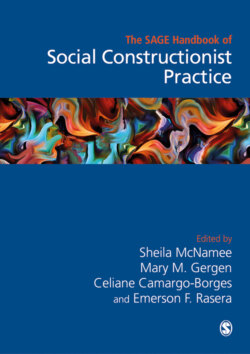Читать книгу The Sage Handbook of Social Constructionist Practice - Группа авторов - Страница 129
На сайте Литреса книга снята с продажи.
Signposting for Transmaterial Worlding
ОглавлениеUnderpinning this signposting is the notion that social constructionist research is inevitably and intentionally perturbing, disruptive, creative, generative, transformative and unexpected – not homeostatic, representational or eliciting of a single truth (Simon and Salter, 2019). These signposts can support the development of new research practice and new professional practice.
The signposts are a fusion of:
1 Criteria for what counts as quality in qualitative research (for example, Bochner, 2000; Cho and Trent, 2009; Denzin, 2000, 2003; Ellis, 2000; Etherington, 2004; Richardson, 2000; Simon, 2018; Spencer et al., 2003; Tracy, 2010);
2 Social constructionist and systemic principles, values and theory (for example, Burnham, 1992; Markovic, 1993; McCarthy and Byrne, 2007; McCarthy and Simon, 2016 McNamee, 2004; Selvini Palazzoli et al., 1980);
3 New materialist theory (for example, Barad, 2007; Braidotti, 2011, 2013; Haraway, 2015, 2016).
Research material…
1 shows critical consideration of where and how voices of transmaterial participants are included in the research;
2 extends communication to include multilingual transmaterial narrative;
3 understands research as an intervention that moves the reader to learn or do something differently;
4 employs creative strategies to tell authentic stories well;
5 clearly states a social responsibility objective which addresses real concerns for people, organisations and the communities in which they live, showing how the practice in the inquiry shows care for/transforms the lives of others;
6 asks daring questions intended to provoke social change and explores the power of narrative and discourse alongside discussion of whose voices and lives matter, and what counts as knowledge, evidence or relevance to the subject;
7 situates experience and description in power structures, local and global contexts, discursive and material systems, historic and contemporary experience, richly inclusive of material from other cultures, materialities, human and non-human systems;
8 provides intimate detail of relational communication from within activities;
9 offers an honest, transparent and reflexive account about the selection of material and interpretation and/or use of the material, why the researchers are doing this research, why now and with what intentions;
10 discusses relational ethics throughout the research process through a rich and overt consideration/critique of power relations, colonising practices, and differences in personal and communal experience, in research relationships and wider socio-political systems;
11 discusses and evidences how the research makes an original and impactful contribution to the field of social constructionist and systemic inquiry, to members of the public, or other professionals, communities or organisations.
